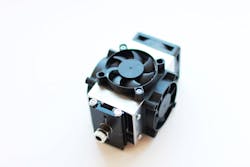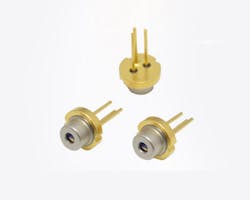There are various types of lasers on the market, but diode (solid-state) lasers are getting some attention due to their power density, portability, and other factors. This article will walk you through some basics about diode lasers, along with how they compare to CO2 and fiber lasers.
Diode Laser Basics
The basis of a solid-state diode laser is, of course, the diode. Laser diodes can have different emission wavelength—most of them have between 405 nm to 808 nm. The diodes usually have TO3, TO5, TO9, or TO18 housings (Fig. 1).
1. These are typical housings for diodes.
Next is the driver. A good laser driver is key to the laser’s long life, in large part because diodes are very sensitive to the initial voltage and current. Different diodes need different drivers to mitigate the voltage and current. For example, the driver from Na UBM44 or NUBM47 laser will not work for the diode M140 laser. A high-quality laser driver should be able to stabilize current and setup current and voltage for a particular laser for proper operation.
Chilling the laser diode is very important. Though typically installed in copper modules (Fig. 2), this laser copper module will not be able to distribute all heat that is generated by a diode if the power of the diode is more than 0.5 W (500 mW). It requires an additional heatsink.
2. Copper’s thermal properties make it ideal for cooling.
A copper laser module (Fig. 3) can be inserted into a heatsink. Once inserted, the laser copper module still might generate too much heat. If so, it will require a fan. Additional air blowing with, let’s say, regular fan with sizes 40 by 40 mm or 50 by 50 mm will help to cool the heatsink. As noted above, chilling the diodes is very important. A cooler module will extend the lifecycle of the laser. In addition, the laser will be able to put out more power.
3. The copper heat sink is mounted on the laser with cooling fans.
When the basic components are brought together:
- Laser diode
- Laser driver
- Laser copper housing
- Additional heatsink
It is necessary to make a focus mechanism for the laser. Most lasers can operate with two types of lens: either a three-element long focal lens or a high-quality G2 efficient short focal lens. The three-element lens can have a focus range of 2-10 cm, while the G2 lens has a 2-10 mm focal range.
4. Distance will play a role in the application of the laser. For example, the G2 lens is more efficient and mostly used for laser cutting.
When the laser focusing is done, the final concern is picking a housing for the entire laser module. The laser housing will depend on the application. However, one of the benefits to using a laser diode is the size. This means they can be mounted on gantry systems such as the ones found on 3D printers of small CNC machines. If this is the end goal, you should make sure that the housing is compatible with the printers and machines in question. Otherwise you will not be able to set up the laser. A lot of laser modules require additional mounting and fastening tools.
Comparing Diode Lasers to Fiber and CO2 Lasers
The key benefit of a diode (solid-state) laser is the ability to make a small unit with a weight that does not exceed 200 grams. The diode’s light weight and size allows it to be installed to almost any 3D printer or CNC machine.
Another big advantage of a diode laser module is that it does not require an additional complicated power supply. A laser diode can operate off a 12 V, 7-8 A power brick. This offers portability and ease of installation to an existing 3D printer or XY plotter that makes the diode laser a great tool for laser enthusiasts, hobbyists, and Makers.
5. A lot of nice things like photo engravings and engraving on metal can be done with 8 W, 10 W lasers with 445 nm wavelength.
Skeptics might will say that a CO2 40 W laser tube could have the same price as for 8 W or 10 W diode laser. The thing is, a high-quality CO2 tube with 40 W to 60 W output will be more expensive than what people think if they are considering a purchase on Aliexpress or Ebay.
Another disadvantage is that the tubes used in a CO2 laser are fragile and larger, making it difficult or impossible to install on a small 3D printer gantry or small CNC machine. CO2 tubes can only be installed on special plotters which also require special power drivers. Also, keep in mind that power consumption for a CO2 laser machine will be much more than for diode laser machine.
Fiber Lasers
A 10 W to 20 W fiber laser machine can costs upwards of $10-15K. This is obviously much more expensive that a diode laser that can run as low as $15 to $50. Of course, fiber laser machines have a lot of advantages comparing to CO2 and diode laser machines. However, this is more robust professional equipment that is not very affordable for beginners or intermediate users.
Diode lasers have great potential, and are a perfect solution for someone who would like to upgrade and bring extension to a 3D printer or CNC machine.
George Fomitchev is CEO and a founder of Endurance. Find him on Facebook, Twitter, and YouTube.






